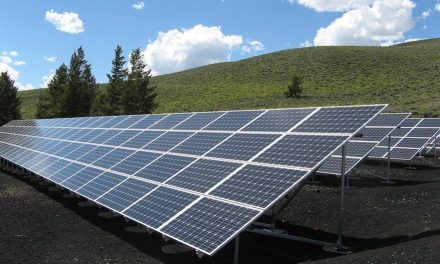Table of Contents
- Introduction
- The Role of Leadership in Navigating the Global Energy Transition
- Overcoming Challenges in Implementing Sustainable Energy Solutions
- Adapting Leadership Strategies to Address the Changing Energy Landscape
- Opportunities for Leadership in Promoting Renewable Energy and Innovation
- Q&A
- Conclusion
Navigating the energy transition: Embrace the challenges, seize the opportunities.
Introduction
Leadership Challenges and Opportunities in the Face of Global Energy Transition
The global energy landscape is undergoing a significant transformation as countries strive to transition towards cleaner and more sustainable sources of energy. This shift, often referred to as the global energy transition, presents both challenges and opportunities for leaders across various sectors. As the world grapples with the urgent need to address climate change and reduce greenhouse gas emissions, leaders must navigate complex political, economic, and technological landscapes to drive the necessary changes. This article explores the leadership challenges and opportunities that arise in the face of the global energy transition, highlighting the need for visionary and adaptive leadership to successfully navigate this transformative period.
The Role of Leadership in Navigating the Global Energy Transition

The global energy landscape is undergoing a significant transformation as countries around the world strive to transition to cleaner and more sustainable sources of energy. This shift is driven by the urgent need to address climate change and reduce greenhouse gas emissions. As the world moves towards a low-carbon future, leaders in the energy sector face numerous challenges and opportunities.
One of the key challenges for leaders in navigating the global energy transition is the complexity of the task at hand. Transitioning from fossil fuels to renewable energy sources requires a comprehensive understanding of the technical, economic, and policy aspects of the energy sector. Leaders must be able to navigate through a complex web of regulations, incentives, and market dynamics to ensure a smooth and successful transition.
Another challenge is the resistance to change from vested interests in the fossil fuel industry. The transition to renewable energy threatens the profitability of traditional energy companies, and they may resist or delay the adoption of clean energy technologies. Leaders must be able to navigate these political and economic challenges and build consensus among stakeholders to drive the transition forward.
However, amidst these challenges, there are also significant opportunities for leaders in the energy sector. The global energy transition presents a chance to innovate and develop new technologies and business models. Leaders who can identify and seize these opportunities will be well-positioned to thrive in the new energy landscape.
One such opportunity lies in the development of renewable energy infrastructure. As countries invest in wind, solar, and other renewable energy sources, there is a growing need for the construction of new power plants, transmission lines, and storage facilities. Leaders who can effectively manage these infrastructure projects will play a crucial role in accelerating the energy transition.
Another opportunity lies in the advancement of energy storage technologies. Renewable energy sources such as wind and solar are intermittent, meaning they are not available 24/7. Energy storage technologies, such as batteries, can help overcome this challenge by storing excess energy during periods of high generation and releasing it when demand is high. Leaders who can drive innovation in energy storage will be able to unlock the full potential of renewable energy sources.
Furthermore, the global energy transition presents an opportunity for leaders to foster international collaboration. Climate change is a global problem that requires a coordinated response from countries around the world. Leaders who can build partnerships and facilitate knowledge sharing will be instrumental in driving the transition on a global scale.
In conclusion, leadership plays a crucial role in navigating the global energy transition. Leaders in the energy sector face numerous challenges, including the complexity of the task, resistance to change, and the need to build consensus among stakeholders. However, there are also significant opportunities for leaders to innovate and drive the transition forward. By effectively managing infrastructure projects, advancing energy storage technologies, and fostering international collaboration, leaders can help accelerate the transition to a cleaner and more sustainable energy future.
Overcoming Challenges in Implementing Sustainable Energy Solutions
Overcoming Challenges in Implementing Sustainable Energy Solutions
As the world faces the urgent need to transition to sustainable energy sources, leaders in the energy sector are confronted with a myriad of challenges. These challenges, however, also present unique opportunities for innovation and growth. In this article, we will explore some of the key challenges faced by leaders in implementing sustainable energy solutions and discuss the potential opportunities that arise from addressing these challenges.
One of the primary challenges in implementing sustainable energy solutions is the high upfront costs associated with renewable energy infrastructure. While the long-term benefits of renewable energy are undeniable, the initial investment required can be a significant barrier for many organizations. Leaders must find ways to secure funding and develop financial models that make sustainable energy projects economically viable. This challenge, however, presents an opportunity for leaders to explore innovative financing options, such as public-private partnerships or green bonds, which can attract investment and accelerate the transition to sustainable energy.
Another challenge is the integration of renewable energy into existing energy systems. The intermittent nature of renewable energy sources, such as solar and wind, poses challenges for grid stability and reliability. Leaders must invest in advanced grid management technologies and develop storage solutions to ensure a smooth integration of renewable energy into the existing infrastructure. This challenge provides an opportunity for leaders to foster collaboration between energy companies, technology providers, and policymakers to develop smart grid solutions that optimize the use of renewable energy and enhance grid resilience.
Furthermore, the transition to sustainable energy requires a skilled workforce with expertise in renewable technologies. However, there is currently a shortage of professionals in this field. Leaders must invest in education and training programs to develop a workforce capable of designing, implementing, and maintaining sustainable energy solutions. This challenge presents an opportunity for leaders to collaborate with educational institutions and industry associations to develop comprehensive training programs that address the specific needs of the renewable energy sector.
In addition to these technical challenges, leaders must also navigate the complex regulatory landscape surrounding sustainable energy. Policies and regulations vary across different jurisdictions, making it difficult for leaders to navigate the legal framework and ensure compliance. Leaders must actively engage with policymakers and advocate for supportive policies that incentivize the adoption of sustainable energy solutions. This challenge provides an opportunity for leaders to shape the regulatory environment and create a favorable business climate for sustainable energy investments.
Lastly, leaders must also address the challenge of public perception and acceptance of renewable energy. Despite the growing awareness of climate change and the need for sustainable energy, there are still misconceptions and resistance to renewable technologies in some communities. Leaders must engage in effective communication and public outreach to educate the public about the benefits of renewable energy and address any concerns or misconceptions. This challenge presents an opportunity for leaders to build trust and foster a positive relationship with the communities they serve.
In conclusion, the transition to sustainable energy presents leaders in the energy sector with numerous challenges. However, these challenges also offer opportunities for innovation, collaboration, and growth. By addressing the challenges of financing, integration, workforce development, regulation, and public perception, leaders can pave the way for a successful global energy transition. With strong leadership and a commitment to sustainability, the energy sector can overcome these challenges and create a more sustainable future for generations to come.
Adapting Leadership Strategies to Address the Changing Energy Landscape
Leadership Challenges and Opportunities in the Face of Global Energy Transition
Adapting Leadership Strategies to Address the Changing Energy Landscape
The global energy landscape is undergoing a significant transformation as countries around the world strive to transition to cleaner and more sustainable sources of energy. This shift towards renewable energy sources, such as solar and wind power, is driven by the urgent need to mitigate the impacts of climate change and reduce greenhouse gas emissions. As the energy sector evolves, leaders in the industry face a unique set of challenges and opportunities that require them to adapt their leadership strategies.
One of the key challenges that leaders in the energy sector face is the need to navigate the complex and rapidly changing regulatory environment. As governments implement policies and regulations to promote renewable energy, leaders must stay informed and ensure compliance with these new rules. This requires a deep understanding of the evolving legal landscape and the ability to adapt quickly to new requirements. Leaders must also be proactive in engaging with policymakers and advocating for policies that support the transition to clean energy.
Another challenge that leaders in the energy sector face is the need to manage the transition from traditional fossil fuel-based energy sources to renewable energy sources. This transition requires significant investment in new infrastructure and technologies, as well as the development of new skills and capabilities within the workforce. Leaders must be able to effectively manage these changes and ensure that their organizations are well-positioned to take advantage of the opportunities presented by the transition to clean energy.
In addition to these challenges, leaders in the energy sector also have a unique opportunity to drive innovation and shape the future of the industry. The transition to clean energy presents a wide range of opportunities for leaders to develop and implement new technologies and business models. By embracing innovation and fostering a culture of creativity and experimentation, leaders can position their organizations as leaders in the clean energy sector.
To effectively address these challenges and seize these opportunities, leaders in the energy sector must adapt their leadership strategies. Traditional leadership approaches that focus on command and control may no longer be effective in the rapidly changing energy landscape. Instead, leaders must adopt a more collaborative and inclusive approach that encourages input and participation from all stakeholders. This requires leaders to be open to new ideas and perspectives, and to create a culture that values diversity and encourages innovation.
Leaders in the energy sector must also prioritize sustainability and environmental stewardship in their decision-making processes. This means considering the long-term impacts of their actions and making choices that align with the goals of the global energy transition. By integrating sustainability into their business strategies, leaders can not only contribute to the fight against climate change but also create a competitive advantage for their organizations.
In conclusion, the global energy transition presents both challenges and opportunities for leaders in the energy sector. To navigate this changing landscape successfully, leaders must adapt their strategies to address the complex regulatory environment, manage the transition to clean energy, and drive innovation. By adopting a collaborative and inclusive leadership approach and prioritizing sustainability, leaders can position their organizations as leaders in the clean energy sector and contribute to a more sustainable future.
Opportunities for Leadership in Promoting Renewable Energy and Innovation
Opportunities for Leadership in Promoting Renewable Energy and Innovation
In the face of global energy transition, there are numerous challenges that leaders must navigate. However, amidst these challenges, there are also significant opportunities for leadership to emerge and drive the promotion of renewable energy and innovation. This article will explore some of these opportunities and highlight the importance of effective leadership in this critical area.
One of the key opportunities for leadership lies in the promotion of renewable energy sources. As the world shifts away from fossil fuels, leaders have the chance to champion the development and adoption of renewable energy technologies. This can be done through advocating for supportive policies and regulations, as well as investing in research and development. By taking a proactive stance on renewable energy, leaders can inspire others to follow suit and contribute to a more sustainable future.
Another opportunity for leadership lies in fostering innovation in the renewable energy sector. As technology continues to advance, there is a need for leaders to encourage and support the development of new and improved renewable energy solutions. This can be achieved through partnerships with research institutions and industry experts, as well as providing funding and resources for innovation projects. By embracing innovation, leaders can drive the transition to a cleaner and more efficient energy system.
Furthermore, leaders have the opportunity to promote collaboration and knowledge sharing in the renewable energy sector. This can be done through establishing platforms for industry stakeholders to come together and exchange ideas and best practices. By facilitating collaboration, leaders can create a supportive environment for innovation and accelerate the adoption of renewable energy technologies. Additionally, leaders can also play a role in promoting international cooperation in the energy sector, fostering partnerships between countries to address global energy challenges collectively.
Leadership in promoting renewable energy and innovation also involves addressing the social and economic aspects of the energy transition. This includes ensuring that the benefits of renewable energy are accessible to all, regardless of socioeconomic status. Leaders can work towards creating inclusive policies and programs that promote energy equity and affordability. By doing so, they can ensure that the transition to renewable energy is not only environmentally sustainable but also socially and economically just.
Moreover, leaders have the opportunity to educate and engage the public on the importance of renewable energy and the benefits it brings. By raising awareness and promoting understanding, leaders can build public support for renewable energy initiatives and policies. This can be achieved through public campaigns, educational programs, and community outreach. Effective communication and engagement strategies are essential for leaders to mobilize public support and drive the energy transition forward.
In conclusion, while there are challenges associated with the global energy transition, there are also significant opportunities for leadership to emerge. By promoting renewable energy and innovation, fostering collaboration, addressing social and economic aspects, and engaging the public, leaders can play a crucial role in driving the transition to a sustainable energy future. Effective leadership in this area is essential for creating a world that is powered by clean and renewable sources, ensuring a better future for generations to come.
Q&A
1. What are some key leadership challenges in the face of global energy transition?
Some key leadership challenges in the face of global energy transition include managing the shift from traditional fossil fuels to renewable energy sources, addressing the economic and social impacts of this transition, navigating policy and regulatory changes, and fostering international cooperation.
2. What opportunities does global energy transition present for leaders?
Global energy transition presents opportunities for leaders to drive innovation and technological advancements in renewable energy, create new jobs and economic growth, enhance energy security and independence, mitigate climate change, and promote sustainable development.
3. How can leaders effectively manage the transition to renewable energy sources?
Leaders can effectively manage the transition to renewable energy sources by setting clear goals and targets, developing comprehensive energy policies and strategies, investing in research and development, promoting public awareness and education, collaborating with stakeholders, and implementing supportive regulatory frameworks.
4. What role does international cooperation play in addressing energy transition challenges?
International cooperation plays a crucial role in addressing energy transition challenges by facilitating knowledge sharing, technology transfer, and financial support. It enables countries to learn from each other’s experiences, harmonize policies and standards, and work together towards common goals, such as reducing greenhouse gas emissions and achieving sustainable energy systems.
Conclusion
In conclusion, the global energy transition presents both challenges and opportunities for leaders. The challenges include the need to navigate complex policy and regulatory landscapes, manage the transition from traditional to renewable energy sources, and address the social and economic impacts of the transition. However, there are also significant opportunities for leaders to drive innovation, foster collaboration, and create sustainable and inclusive energy systems. Effective leadership will be crucial in addressing these challenges and seizing the opportunities presented by the global energy transition.





Recent Comments